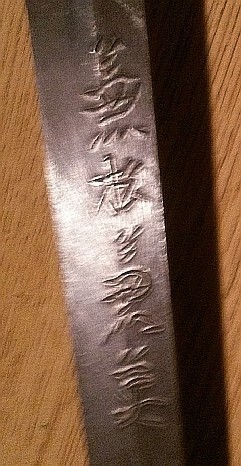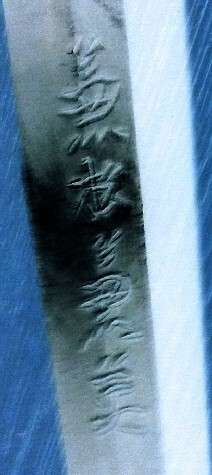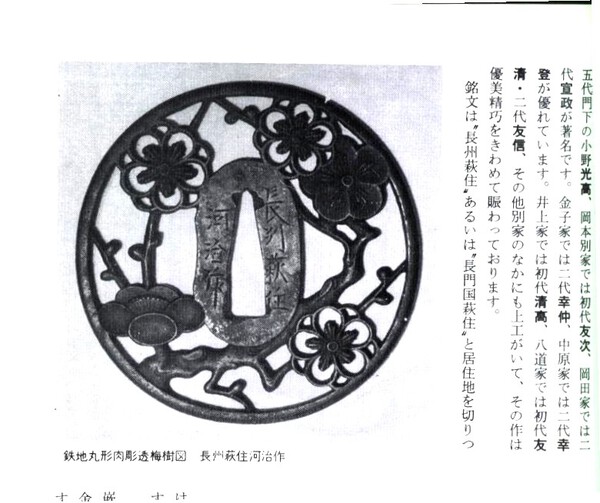-
Posts
703 -
Joined
-
Last visited
-
Days Won
4
Everything posted by Ron STL
-
One correction to my description. The shinsa team dated the ken to TENWA 1681, not Kanbun as I wrote earlier. Ron STL
-
I am looking for a book example showing the mei of Naotsugu, said to be an early name of shodai Mishina Tango no kami Kanimichi. Info is in the Meikan p.656 (my edition) and in Fujishiro (translation page) p. 87...I don't recall the Japanese text page number at the moment. I have a beautiful ken signed: Kiishu ju Fujiwara Naotsugu, papered, Kanbun era. (once owned by Dean Hartley). Ubu ken still showing ubu-ba on both edges. Hamon begins yakiotoshi ~1.5 cm above machi. I've found only one Naotsugu from Kanbun listed, but have never found an example of his mei. Nor do I find any mention of his living in Kii Province. If anyone can post (or email) me copy of an example, that would be great! I've expired my personal references. Attached is a photo of my ken, along with a rubbing of the nakago. Sorry for the lack of better photos, but for now, the better ones are "lost" at the moment. What happens when you try to get too organized! Wonderful jigane in this ken. Ron STL
-
Thanks everyone, I didn't expect to get so much info on this smith. I'll print this out and give it to my friend tomorrow. Have a few of the sword guys coming over tomorrow. NMB...always a good source for information! Thanks again. Ron STL
-
A Showa stamped blade...trying to help a friend out here. Looks like AMA--- KANEMASA to me, but would appreciate a correct, full translation. Thanks! Ron STL
-
Honestly, I'm amazed at the findings here. The mei centered down the shinogi seemed absolutely not what one would expect on a Japanese swords. I just checked my nidai Tadatsuna and sure enough, the mei is carved right down the shinogi! I've had this Tadatsuna for quite a few years and have shared it with others; nobody ever commented on the placement of the mei. Fifty years and counting...and still learning fresh information. Ron STL
-
Peter, Peter, Peter...you said it all. Thanks all. Ron STL
-
Thanks guys, I had this possible concern myself when seeing the photo of the sword. The one I posted was a negative image which seemed to show the kanji clearer, but I'll post the positive image here for what it's worth. Still a fuzzy excuse for a photo! The nakago also appears brand spanking new. I didn't notice that the mei was carved right down the shinogi, but that certainly points to fakeroo work! I never saw a dual smith mei that was written like this (without more of a statement). If my friend has put money on this...uh..."sword"...guess he needs to learn more about swords. I'll wait and see if anyone else cares to comment on this and then pass on the (what looks like) bad news. Thanks for the additional "eyes" looking at this. Looks like the last Kane--- will not make much difference if it's understood or not. Thanks Ron STL
-
Apologies for the poor photo sent to me for translation. This sword looks pretty "new" from I can tell, and may be something made by two smiths, the first being KANETADA and the other KANE? Or...the last part is actually saying something else. Only four Kanetada listed in Hawley from c.1492, 1818, 1955 and 1960. Just trying to identify the maker for the owner while satisfying my own curiosity about the full reading. Thanks! Ron STL
-

What is this "smokestack"spray of ko-nie feature?
Ron STL replied to Ron STL's topic in Translation Assistance
Thanks Chris. I can see this being called yo on the second oshigata, now that you mentioned it. Too bad the first example does not mention it at all. I just searched "What is dan utsuri" and found this on the Usagiyu sword shop (Tokyo) site and found the attached drawing. Just something to consider. Ron STL -

What is this "smokestack"spray of ko-nie feature?
Ron STL replied to Ron STL's topic in Translation Assistance
Thanks Paul. Maybe this as you suggested, dan utsuri, but looking at the kanji I can't see the kanji for dan utsuri (or any utsuri) in the text. In Gordon Robson's Glossery of Terms he describes dan utsuri as "...distinctive bands moving up the length of the blade." So I guess that could be describing what's on these oshigata. I'm not positive that the utsuri described rises vertically from the tops of the gunome/togariba or if it is layered horizontally above the hamon as one would expect to see utsuri do. Gordon mentions Bizen Kanemitsu and also Aoe works showing dan utsuri. Another person mentioned dan utsuri being found on Nio works. Maybe we'll get a full reading of the descriptions on these oshigata to see if anything is mentioned about this, so prominently shown on the oshigata. I'm studying a sword right now that has what looks to be this same (similar) thing on it. I'll look again at it, but on the sword it appears formed by a ko-nie rising into the ji from a few gunome or togari. (The hamon displays gunome, some more pointed.) It would be nice to get a better understanding of what we are looking at. Ron STL -
Looking in Nihonto Zuikan Kotohen under Tametsugu and Bitchu in general, I came across these two examples with this rather unique "smokestack" characteristic shown. Tametsugu and Nagatsugu. I would dearly love to know what the descriptions say about the steel and hamon for these two smiths. Help somebody who can read Japanese! Thank you, thank you! Ron STL
-
Here is a depiction of the "Little Dipper" on the nakago of a ken. Another local collector has a wonderful tsuba that shows this constellation. Interesting to find this used on swords and fittings. Ron STL
-
Just to point out what treasures might be waiting for buyers to find them -- Arnold's possible Heian blade is one example -- the most exciting discovery shown to me by it's lucky buyer was a fantastic in polish and papered tanto by Awataguchi Kuniyoshi, no less. Playing the kantei game, my first impression was Rai Kunimitsu. Told to think earlier in the Yamashiro smiths, I recognized the absolutely incredible jigane and the two short hi on one side, ken on the other as typical Awataguchi. That was good enough! How could I miss that Awataguchi hada!!! I find it totally amazing how a "little piece of steel" can bring one to his knees...but that it did. Equally wonderful is that it found an appreciative and deserving owner who will admire and preserve it, and share it, for many decades to come. Reportedly, the tanto was offered on a dealer's table. It took a good eye and knowledge to immediately recognize the importance of the wonderful tanto. This just shows the importance of attending the shows; treasures do surface from time to time. The only negative comment...I was not that "lucky buyer." Ron STL
-
Ken, maybe it's time to put my Kaga tsuba into your hands at a much, much lower price than these auction house prices. I'll talk to you about this not this week, but next week, okay? Maybe it'll make you feel better! Ron STL
-
Just wanted to mention that I shall be setting up a display of swords by shinshin-to smiths Jirotaro Naokatsu and his son, Shoji Yamon Naokatsu, next to my show table. There will be (4) swords by Jirotaro (1st) and two swords by Yamon (2nd). I'll also set out four tsuba by Jirotaro and maybe one by a student of his, Naoaki. I've put together record sheets plus copies of Jirotaro's (4) Juyo Token examples, which I'll layout for those interested. The display will give everyone good exposure to the work of Naokatsu, Naotane's son and student. Please take time to visit...Ron STL
-
Nobody ever explained this inscription. A local friend came up with: It says "Made with enthusiasm" which makes sense. Ron STL
-
Here is an iteresting iron tsuba that was acquired yesterday when the boys were over. Thought I'd share it and see if anyone cares to comment on it. My thinking is early Heianjo, Momoyama. The tsuba measures 70mm x 69mm x 5 mm and appears cut down. It and now had a shakudo rim. The one large hitsu-ana is interesting; the one is has a shakudo plug but both histu-ana are lined with brass. The brass inlay is flush with the surface. The nakago-ana has been worked on both sides of the tsuba, but the primary side appears to be photo 202b (large ana to left of nakago-ana). Lovely old tsuba. Just curious if my opinion sounds correct or if anyone has a different kantei of it. Ron STL
-
Here is an interesting mei by Yamato no kami Fujiwara Tadayuki. But the additional kanji is puzzling the St. Louis boys Today. Help please... Ron STL
-
John, I think your correct with the placename on this tsuba. I did have a full view with my intiial posting. See if that helps. Ron STL
-
I've heard that ko-Hagi (if that's the correct name for early Choshu tsuba) were made with both sides identical. The tsuba I use with my name on NMB is one of those earlier tsuba; it is identical on both sides. I'll also attach a copy of p. 163, Tsuba Kodogu Kantei Nyumon that shows a signed example of this same design. Mei is: Choshu Hagi ju Kawaji saku (note the Kawaji, Fred). I've no idea if this book example is identical both sides or not. Ron STL
-
David, the design of actually the backside of the front design; front on a flower or leave, back of flower or leave when turning the tsuba over, as done on Choshu work. By the way, I think your thoughts on ibota wax causing the gloss is very likely correct. Ron STL
-
You haven't seen the blade??? Yes, the blade is in hand, but the question was, what did the shinsa call it. It looks as if might be naginata-naoshi rather than made in unokubi form. But, I could see the kanji was not saying that. It made me wonder if the shinsa saw something I do not see in the shape of the sword. At 50 cm it seemed long for unokubi form, but obviously not if that's how the team saw it. Let's see if I can briefly explain why I'm studying this sword; it's not even my sword. The sword was bounced as saiha, retemper, and clearly displays a very obvious mizukage. However, the sword is koto (my thinking) and in a quality polish. Somebody thought a lot of this sword. Slightly suriage, only a partial mei -- Chikushu Shinbei -- remains. (This could be Chikuzen or Chikugo, both are abbreviated as Chikushu; I think it is Chikugo.) My friend who owns the sword was of course disappointed in the shinsa results. My point is, it is still a beautiful old sword that survived centuries as a keepsake. Let's give it some appreciation for what it is. If truly retempered, it was a well done retemper by somebody who knew what they were doing. A bit idealistic thinking? Well, that's just me. So, at this point I have been trying to fill in the blanks and assign the sword to some school and era. Let's call it guesswork. Ron STL
-
Thanks Chris, I thought that should be it but again, the "handwriting" can prove difficult. Ron STL
-
-
For awhile now I've been struggling with identifying who made this iron sukashi tsuba. It definitely seems to have Choshu characteristics, but it must be something else. The right side of the mei looks more like a town name "----gawa ju" since it'snot a province. As for the tsuba-ko, one thought was Munenaga, but again I'm not quite convinced the first kanji reads "mune." Can anyone take us one step closer to identifying the tsuba? The tsuba does have a glossy look to it which, as David pointed out to me, could be ibota wax. It doesn't appear burnt. Ron STL



















